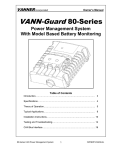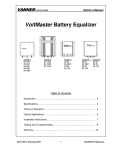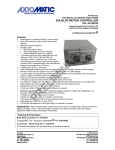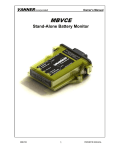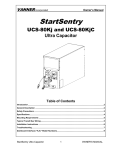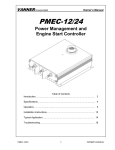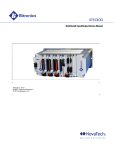Download Voltmaster C-Series Owner`s manual
Transcript
VANNER Incorporated Owner’s Manual VANN-Guard 70-Series Power Management System With Internal Electronic Monitor Table of Contents Introduction………………………………………………….………………… 3 Specifications…………………………………………………….………….… 4 Theory of Operation……………...…………………………………………… 5 Typical Applications…………………………...…………….…………..…… 8 Installation Instructions………………………….………...…………………. 10 Testing and Troubleshooting………………………………………………… 13 70-Series Power Management System 1 OWNER’S MANUAL VANNER Incorporated 70-Series Power Management System Owners Manual 2 OWNER’S MANUAL VANNER Incorporated Introduction Introduction Thank you for purchasing a Vanner VANN-Guard Power Management System. We are confident that you will be very pleased with its performance because our 70-Series are designed and manufactured by skilled professionals using the highest standards in workmanship. With minimum maintenance and care, you can be assured of many years of trouble free service. General Description The Vanner VANN-Guard Power Management System is an efficient and highly reliable method of obtaining a 12 volt DC power source from a 24 volt DC electrical system. The VANN-Guard makes the batteries look like they are in series and parallel at the same time. In addition to providing regulated 12 volt power, the system ensures that battery voltages remain equal which significantly extends battery life. Ideally suited for vehicle and alternate energy applications, the VANN-Guard is designed to save your batteries and the money you would spend replacing them. Users of the Vanner VANN-Guard know that it is the most cost effective and dependable solution for dual voltage systems. The Internal Electronic Monitor is a device designed to monitor several critical functions in the electrical system. This unit provides fault signals that can be wired to warning lights, buzzers or other control/warning devices. A typical system would include a 24VDC power source, such as an alternator or solar array, two 12 volt battery banks in series, and the VANN-Guard. The VANN-Guard connects to the 24 volt, 12 volt and ground terminals of the battery system. When the 12 volt loads require power, the VANN-Guard ensures that the current is taken equally from both batteries, and that the voltages of the two batteries are kept equal. This equalization ensures extended battery life and provides a stable 12 volt supply for operating accessories. Paralleling VANN-Guard: Models are available which provide 60, 80 and 100 amps of 12 volt DC power. VANN-Guard may also be operated in parallel to provide more power. For example, two 60 amp units can be installed to provide 120 amps of 12 volt DC power. NOTE: The Vanner VANN-Guard Power Management System is an extremely reliable device and, when installed according to the instructions, will provide reliable operation for an indefinite period of time. However, if a system abnormality should develop that would cause a VANN-Guard malfunction, damage to the battery system could result if 12 volt loads are present. 70-Series Power Management System 3 OWNER’S MANUAL VANNER Incorporated Specifications Specifications 70-Series Equalizers Model Number 70-60M 70-80M Input Voltage 24v Efficiency (Peak) Max 24v Input Amps 18 to 32 v >97% >97% >97% 32 43 53 Output Voltage Output Amps (12v) 70-100M (Input Voltage/2) ±2% 0-60 Standby Current 0-80 0-100 17 milliamps nominal at 28.4V Electronic Monitor Alarm Low/High, Imbalance, Undervoltage protect override, Vann-Guard fault Operating Temp. -40°C to +75°C (-40°F to 167°F) Storage Temp. -54°C to +95°C (-65°F to 203°F) Serviceable Environmental Considerations Mounting Location Weights Yes Yes Yes Cast aluminum enclosure provides protection against salt, fungus, dust, water, fuel vapors and all fluids associated with commercial and off-highway vehicle operations. IP rated 56. Mount on a flat surface close to the batteries to allow short cable runs. Location should be protected from battery acid and gases. 8.7 lbs. 8.9 lbs. 9.3 lbs. 70M-Series Dimensional Specifications 0.31 (7) 5/16-18 x 9/16 STUD TORQUE 120 LB-IN MAX 10.6 (269) 8.0 (203) 5.1 (130) 1.3 (33) 0.5 (12.7) (71) 2.8 8.0 (203) 8.5 (216) 70-Series Power Management System 3.4 (86) 4.0 (102) 4 OWNER’S MANUAL VANNER Incorporated Theory of Operation Theory of Operation +24V F2 + 12 V Battery B - +24V VANN-Guard +12V F1 + 24V Alt - +24 Volt Loads +12 Volt Loads + 12 V Battery A - +12V GND In many 24 volt electrical systems it is desirable to tap into the battery system to obtain power for 12 volt loads. This method, while seemingly simple, causes a charge imbalance resulting in Battery B (see diagram) being overcharged, and possibly boiling, while Battery A discharges. To solve this application problem the Vanner VANN-Guard is connected to the battery system at the +24 volt, +12 volt, and ground points. The VANN-Guard makes the batteries look like they are in series and in parallel at the same time. The VANN-Guard maintains the voltage balance and therefore the charge acceptance rate of each battery. The VANN-Guard hold Battery A and B voltages to within 0.05 volts under light loads and to within 0.1 volts at full rated load. When the voltage of Battery A is higher than or equal to Battery B the VANN-Guard is in the standby mode, i.e., it is not transferring power from its 24 volt input to its 12 volt output. When a 12 volt load is present, and Battery A's voltage decreases to just below the voltage of Battery B, the VANN-Guard activates and transfers sufficient current from Battery B to Battery A to satisfy the load and maintain an equal voltage and charge in both batteries. A key advantage of a system containing a Vanner VANN-Guard, compared to a DC to DC converter, is that if the 12 volt load requires a momentary surge current which exceeds the rated capacity of the VANN-Guard, Battery A will supply the extra current to the load. The VANN-Guard will then replenish the energy to Battery A after the surge has passed. The following scenarios describe the VANN-Guard Power Management System operation. Scenario #1 - 24 volt load present, no 12 volt load present. The system operates as a system would without the VANN-Guard whether the alternator is ON or OFF. The VANN-Guard is in the standby mode except for making small adjustments to keep the batteries in balance. Scenario #2 - Both 24 volt and 12 volt loads present, alternator is OFF. The VANN-Guard will insure that both batteries will discharge at the same rate even if different loads are present. Scenario # 3 - Both 24 volt and 12 volt loads present, alternator is ON. The alternator provides 24 volt power to the battery system and to the 24 volt loads. The VANN-Guard transfers power from the 24 volt source to the 12 volt load by converting 24 volt power to 12 volts. It will supply sufficient 12 volt power to satisfy the 12 volt load and to maintain battery voltage balance. 70-Series Power Management System 5 OWNER’S MANUAL VANNER Incorporated Typical Applications Monitor functionality All functionality described in this section requires that the Monitor Ignition Input (Terminal B) be high in order to be active. All of the fault outputs have internal pull-ups to the +24v supply of 10K ohm. A. Alarm Low Output This output is pulled to ground if the 24V bus is below 24 volts, indicating an alternator or regulator failure. B. Monitor Ignition (Enable) Input This input enables the monitor function, when this pin is taken to +24V then the monitor becomes active. See below for more information. C. Ground D. Imbalance Alarm Output This output is pulled low if the batteries are out of balance by more than 6%, this could indicate a 12V bus overload, a dead battery condition, or an Equalization failure. E. Alarm High Output This output is pulled low if the +24V bus is above 30 volts, indicating an alternator regulator failure. F. Undervoltage Protection Override If this pin is pulled high (more than 6V) the low voltage lockout on the lower battery is disabled, this is to allow jump starts with two wire jump, the added protection is then not available. See below for more information. –Note: some Equalizers available in the market do not have undervoltage protection. G. Equalizer Fault Output This pin is pulled low when the Equalizer is faulty. See below for more information. H. Equalizer Disable Input This is a control pin for the Equalizer, if it is pulled low the Equalizer will be disabled. If it is left disconnected, or pulled high, the Equalizer will function normally. J. Remote Sense Fault Output If the compensation voltage (the total difference between the voltages at the equalizer and the voltages measured by the remote sense) exceeds 1.5v, the Remote Sense function is disabled and this pin is pulled low. K. Unused L. Unused M. +24V Battery Remote Sense If this pin is connected directly to the +24V battery positive by a separate line, it will improve the accuracy of the Equalizer balance of the batteries when load current is drawn. See below for more information. N. +12V Battery Remote Sense If this pin is connected directly to the +12V battery positive by a separate line, it will improve the accuracy of the Equalizer balance of the batteries when load current is drawn. See below for more information. P. Battery Ground Remote Sense If this pin is connected directly to the battery ground by a separate line, it will improve the accuracy of the Equalizer balance of the batteries when load current is drawn. See below for more information. The monitor output from the unit is through a Deutsch brand connector P/N: HDP20-18-14PN. The mating connector is the Deutsch P/N: HDP26-18-14SN housing with Deutsch P/N: 1062-16-0622 socket contact. 70-Series Power Management System 6 OWNER’S MANUAL VANNER Incorporated Typical Applications Undervoltage Protection Override (Jump Start Override) (Terminal F) This is an input, which overrides the low battery undervoltage lockout if the 24V bus is above 19VDC. The intent is to detect an attempted jump start so that the 12V bus can be powered in the event of a totally flat battery, and a 12V load present, with a two wire jump (12V battery does not have a jump connection, only the 24V and ground). If this line is allowed to float it will not be activated, to activate this feature this line should be tied to the 24V bus. Equalizer Fault Output (Terminal G) This is an indicator output with the same characteristics as the other monitor outputs, they can be wired together for a single warning, or discretely wired for more detailed information. This output is a pull down whenever an Equalizer fault is detected. There is logic in the monitor, which examines Equalizer behavior to decide if there is a fault. This is a significant improvement over previous indicators used in the industry, which simply show if the Equalizer is active. Those indicators give rise to false replacements if, for example, the batteries are balanced and the Equalizer stops running. Equalizer Ignition Input (Terminal H) This input allows the Equalizer to be turned on and off by an external control signal, such as the ignition line. This line should be pulled low to turn off the unit, if it is left to float the Equalizer is enabled. If this line is tied to the ignition there will be enough additional load on the ignition line to perform the “pull down” function. Remote Sense (Terminals M, N, and P) Remote Sense allows remote sensing of battery voltage. This makes the Equalize function insensitive to voltage drops in the cables, fuses and connections. Remote Sense allows flexibility of configuration in the Equalizer power connection wiring and more freedom in Equalizer location. When using Remote Sense the Equalizer DC power cables can be the minimum size listed in the Wire Size Table for a given Equalizer rating, up to four times the distance listed. This sets a maximum voltage drop of 0.4V which is reasonable from efficiency and fault detection considerations. There are three inputs for the Remote Sense function, +24, +12, and Ground. The Remote Sense wires can be 16 or 18AWG as the input impedance is high. Select the wire gauge based on mechanical strength requirements. The Remote Sense wires each should have appropriately sized fuses for protection in case the wires become damaged or shorted. It may not be necessary to connect the Remote Sense wires directly to the battery. If the vehicle battery cables are brought to a distribution point from where connections are made to the rest of the vehicle, it is acceptable to connect the Remote Sense wires here. Sensing at the distribution point should not introduce a significant error since most of the time the battery cables are only carrying battery charging current. As the battery become charged and the charging current becomes minimal there will be almost no error. Deutsch Connector Pin Out Alarm Low VANN-Guard F1 +12 Volt Loads (Radio) Imbalance Alarm + Voltage for Lamps D Alarm High + Voltage for Lamps E + Voltage for Lamps G H + Voltage for Lamps J K L M N P +24V +12V +24 Volt Loads A B C Ground F2 + 12 V Battery B - + 24V Alt - + Voltage for Lamps Monitor Ignition Input +24V + 12 V Battery A - Undervoltage Protection Override +12V Equalizer Fault GND Equalizer Ignition Input Remote Sense Fault N P D M Control Input: +24VDC Output: 0.375 Amps (per term.) Trip Levels: all have 5 second Delay) 70-Series Power Management System L F A C Battery Monitor G B K Unused E J 7 H Unused +24V Battery Remote Sense +12V Battery Remote Sense Battery Ground Remote Sense F OWNER’S MANUAL VANNER Incorporated 70-Series Power Management System Typical Applications 8 OWNER’S MANUAL VANNER Incorporated Typical Applications Typical Applications Vanner VANN-Guard Power Management Systems are used in many types of applications including transit and tour buses, private coaches, heavy trucks and off highway equipment, yachts, and alternative energy systems such as solar powered homes. In addition to VANN-Guards, Vanner manufactures a wide range of complementary products such as DC to DC converters, DC to AC inverters, battery charger/conditioners, and battery isolators. The following system diagrams illustrate how these products are used in various applications. TRANSIT BUS +24V F2 + 12 V Battery B - +24V VANN-Guard +12V F1 + 24V Alt - +24 Volt Loads +12 Volt Loads +12V + 12 V Battery A - GND PRIVATE COACH +24V +24V Vanner Battery Isolator or Other Paralleling Switch F5 +24V F2 + 12 V Battery B - F4 + 12 V Battery B - +24V VANN-Guard +12V +24 Volt Loads +12 Volt Loads + +12V - +12V F1 + 24V Alt - +24V VANN-Guard + 12 V Battery A - F3 +12V +12 Volt Loads GND Coach Batt. Sys. + 12 V Battery A - Vanner DC to AC Inverter GND 120VAC Loads House Batt. Sys. Applications Continued: 70-Series Power Management System 9 OWNER’S MANUAL VANNER Incorporated Typical Applications TOUR/CHARTER COACH +24V F2 + 12 V Battery B - +24V VANN-Guard + +12V - +12V F1 + 24V Alt - +24 Volt Loads + 12 V Battery A - +12 Volt Loads Vanner DC to AC Inverter GND 120VAC Loads MARINE +24V +24V Vanner Battery Isolator or Other Paralleling Switch F6 F5 +24V +24V F2 + 12 V Battery B - F4 + 12 V Battery B - +24V VANN-Guard +12V + 24V Starter - +12 Volt Loads + +12V - +12V F1 + 24V Alt - +24V VANN-Guard + 12 V Battery A - F3 +12V GND +24 Volt House Loads +12 Volt House Loads Engine Batt. Sys. 70-Series Power Management System + 12 V Battery A - GND Vanner Battery Charger From Main AC Panel + - Vanner DC to AC Inverter To Auto Transfer Switch House Batt. Sys. 10 OWNER’S MANUAL VANNER Incorporated Testing and Troubleshooting Installation Instructions Do not exceed the specified torque of 120 in-lbs. when connecting cables to the terminal posts (+24, GND, +12) during installation of all the VANN-Guard Models. Torque values higher than specified may damage the product, reduce performance, and/or create hazardous conditions. Products damaged by improper torque are not covered by the warranty. Do not connect more than one conductor per terminal post on any Vanner VANN-Guard. Multiple wires and cables may overstress internal components, resulting in poor performance or creating hazardous conditions. Products damaged by the installation of multiple conductors per post are not covered by the warranty. Fault protection devices must be installed between the VANN-Guard and the power source (battery). A fault protection device would be any fuse or circuit breaker properly rated for the maximum DC current obtainable. This advisory is in accordance with SAE, NEC and UL, for mobile power applications. Install per applicable codes or within 18” of the battery. See Wire and Fuse Sizing Chart on page 10 of this manual or contact Vanner at 1-800-227-6937 or [email protected] if assistance is needed in sizing fault protection devices. Caution: This equipment tends to produce arcs and sparks during installation. To prevent fire or explosion, compartments containing batteries or flammable materials must be properly ventilated. Safety goggles should always be worn when working near batteries Mounting Location –The VANN-Guard may be mounted in any orientation, on a flat mounting surface suitable to support the VANN-Guard during application. Do not mount in zero-clearance compartment that may result in the VANN-Guard overheating. Locate so that contact by people is unlikely. Environmental Protection – Your VANN-Guard has been designed to withstand direct exposure to rain and moisture. The VANN-Guard has also been tested for exposure to direct pressure spray, but continual exposure to direct pressure spraying may reduce the VANN-Guard serviceable life. Any damage due to water contamination is covered by Vanner only through the terms of our factory warranty. Wiring Sequence– The VANN-Guard is internally protected for reverse polarity. The wiring sequence is not an issue with the VANN-Guard products. Strain Relief – The VANN-Guard has an integral strain relief. The VANN-Guard is designed with wells for the lug to sit into to resist bolt loosening from cable movement, and the strain relief is designed to further inhibit cable movement. The diagram below shows the proper orientation for the attachment of the strain relief and the #10-32 mounting hardware that is supplied. MOUNTING SCREWS CABLE STRAIN RELIEF LUG WELLS VANN-Guard 70-Series Power Management System 11 OWNER’S MANUAL VANNER Incorporated Testing and Troubleshooting Caution adding 12volt batteries Acceptable +24V + 12 V Battery B - Unacceptable +24V Battery A and Battery B Are The Same Size F2 Battery A and Battery B Are NOT The Same Size F2 + 12 V Battery B - +24V VANN-Guard +24V VANN-Guard +12V +12V + 24V Alt - + 12 V Battery A - GND +12V F1 F1 + 12 V Battery C - + 12 V Battery C - + 12 V Battery C - + 24V Alt - +12V + 12 V Battery A - GND F1 + 12 V Battery A - + 12 V Battery A - + 12 V Battery A - In certain applications, such as private coach or alternate energy applications, it may be desirable to have additional 12 volt “House Batteries” to operate heavy 12 volt (inverter) loads. Use the VANN-Guard to charge the additional batteries. Connect the VANN-Guard 12V terminal to the additional batteries only. Do not connect the VANN-Guard 12V terminal to both battery banks as this would make Battery A larger than Battery B. Damage to Battery B may occur during charging due to overcharging, if the VANN-Guard cannot keep up with the charging system. Caution using a Ground-Side Battery Disconnect Switch +24V F2 + 12 V Battery B - High Current Diode +24V VANN-Guard +12V F1 + 24V Alt - +24 Volt Loads + 12 V Battery A - +12 Volt Loads (Radio) +12V GND Battery Disconnect Switch The system must be wired as shown to prevent Reverse Polarity Damage to polarity sensitive12 volt loads while the ground-side disconnect switch is open. The VANN-Guards GND terminal must be wired to the battery side of the ground-side disconnect switch circuit for the VANN-Guard to work properly. Install the external High Current Diode, such as Vanner Model 52-75 (45 amp continuous rating) to protect polarity sensitive 12 volt loads if these loads do not already contain input diode protection. This prevents a reverse polarity on the 12 volt equipment when the battery switch is open. The reverse polarity does not come from the VANN-Guard, but from any 24 volt equipment that may be turned ON. 70-Series Power Management System 12 OWNER’S MANUAL VANNER Incorporated Testing and Troubleshooting Wire Size and temperature rating Cables connecting the VANN-Guard to the batteries must be sufficiently sized to prevent unwanted voltage drops. These voltage drops (loss) must be less than 0.05 VDC between the VANN-Guard’s +24 volt terminal and the battery +24 volt terminal (Battery B positive terminal), less than 0.10 VDC between the VANN-Guard’s +12 volt terminal and the battery +12 volt terminal (the jumper between Battery A and Battery B), and less than 0.05 VDC between the VANN-Guard’s GND terminal and the battery ground terminal (Battery A negative terminal that is connected to chassis ground). In most installations, the VANN-Guard’s terminals are wired directly to the battery terminals (reference fault protection) to prevent voltage loss that could occur in switch contacts, connections, and long wire runs. Since the VANN-Guard can be operated in temperatures up to 75ºC, use wire rated at least 90ºC. See Wire and Fuse Size Chart. Wire and Fuse Size Chart Wire Size AWG #8 #6 #4 #2 #1 #1/0 #2/0 Ring Terminal AMP or UL recognized equal 33462 33466 33470 322870 321867 321867 321870 Fuse F1 Fuse F2 Max wire length, in feet, between VANN-Guard and battery to keep voltage drop under 0.1 volt. The chart assumes wire carries no other load and wire temperature is below 80ºC. 70-60M 70-80M 70-100M 2 X 70-100M 2.1 3.2 5.9 8.7 10.9 13.8 17.6 80 amp 40 amp XXX 2.4 4.4 6.5 8.2 10.4 13.2 100 amp 50 amp XXX XXX 3.5 5.2 6.5 8.3 10.5 125 amp 80 amp XXX XXX XXX 2.6 3.3 4.1 5.3 250 amp 150 amp Crimp the ring terminals using AMP ROTA-CRIMP 600850 (2/0 - 8ga). AMP Product Information Center: 800-522-6752 AMP Tooling Assistance Center: 800-722-1111 Note: The wire gages listed are for use without remote sense, see the monitor section for applications using the remote sense capability. 70-Series Power Management System 13 OWNER’S MANUAL VANNER Incorporated Testing and Troubleshooting Testing and Troubleshooting CAUTION Servicing of electrical systems should only be performed by trained and qualified technical personnel. Equipment Required VoltMeter having 0.01 volt resolution. (Fluke Model 87 Multimeter recommended). Clamp-on amp meter (Fluke Model 36 Clamp-on Meter recommended). Vanner Repair Service Vanner offers a quick turn around factory repair service. Send the unit to the address below with a note instructing us to repair it. Include your name, phone number, shipping address (not a P.O. Box Number), and your purchase order number. Test Procedure for VANN-Guard 70-Series Power Management Systems The VANN-Guard is working properly if: 1. The 12 volt DC loads are being operated continuously and are within the rated capacity of the VANN-Guard and; 2. Battery A voltage is lower than Battery B by no more than 0.05 to 0.10 volts (measured at the VANN-Guard’s +24, +12 and GND terminals). Vanner VANN-Guards are electronically protected against reverse polarity damage therefore the DC connection sequence is not an issue. Vanner VANN-Guards will not function properly unless all three battery connections are made. Battery A and Battery B voltages both must be above 8 volts for the unit to turn ON. Vanner VANN-Guards may be used in parallel with other VANN-Guards and Vanner Equalizer models. Please note that the 24V, 12V and GND stud position and orientation are different on VANN-Guard 70Series than on other Vanner Equalizers. VANN-Guard Test Procedure: 1. Field-test the equalizer while fully connected to the vehicle batteries. For bench testing, two 12 volt batteries, or two 12 volt power supplies are required. The VANN-Guard must be connected to the batteries at GND, 12V and 24V to function properly. 2. If battery voltage is below 24 volts start the vehicle or apply a 24 volt battery charger to the batteries. 3. Turn ON 12 volt DC loads up to the VANN-Guard’s rated capacity. Measure DC amps on the VANNGuard +12 cable to verify load amperages. 4. At the VANN-Guard measure and record: a. Battery A voltage (voltage between the VANN-Guard’s +12 and GND terminals) b. Battery B voltage (voltage between the VANN-Guard’s +24 and +12 terminals) 5. Subtract Battery A voltage from Battery B voltage and compare readings. 70-Series Power Management System 14 OWNER’S MANUAL VANNER Incorporated Testing and Troubleshooting VANN-Guard Status Voltage Comparison a. b. c. Battery A is lower than Battery B but within 0.05 volt. OFF Battery A is lower than Battery B by 0.05 to 0.10 volts. Battery A is lower than Battery B by more than 0.10 volts d. Battery A is lower than Battery B by more than 0.10 volts e. Battery A is higher than Battery B Stand-by Mode. The VANN-Guard will not turn ON until Battery A is lower than Battery B by more than 0.05 volts. ON Normal Operating Mode ON Self-Protection Mode due to Overload Condition. See below. OFF The VANN-Guard is not functioning properly. Abnormal condition. Suspect Battery B is defective or a 12 volt load is connected to Battery B. Overload Condition An overload condition exists when the 12 volt loads exceed the VANN-Guard’s rated capacity. The overload condition will not damage the VANN-Guard, but may cause damage to the batteries. During the overload, the VANN-Guard’s output is limited by internal protection circuits to its Rated Output Amps. The 12 volt amps exceeding the VANN-Guard’s output are drawn from Battery A which will begin to draw the batteries out of balance. The VANN-Guard’s full Rated Output Amps are maintained as long as Battery A and Battery B remain balanced within 0.10 volt. The internal protection circuits will reduce the VANN-Guard’s output as the batteries become further out-of-balance. If Battery A voltage falls below approximately 8 volts the VANN-Guard will shut itself OFF. To correct the overload condition the 12 volt load must be reduced, or the VANN-Guard’s rated capacity must be increased. Trouble Shooting an Engine No-Start Situation Situation: A coach has dead batteries and won’t start while jump starting. The coach is equipped with a 24 volt starting and charging system, a 12 volt electronic diesel engine control, a VANN-Guard, and a moderate 12 volt load which cannot be turned OFF. The coach sits for several days and the batteries run completely dead. During jump-starting the engine cranks but does not start due to low voltage on the 12 volt supply. Electrical testing reveals there is no 12 volt output from the VANN-Guard while jump starting even though the VANN-Guard separately tests OK. Cause: The 12 volt load which could not be turned OFF first ran both batteries down until the VANN-Guard shut itself OFF due to low voltage. (The VANN-Guard will shut OFF if system voltage falls below 16 volts or if voltage on either battery falls below 8 volts.) Then Battery A alone was drained to near zero volts. As the bus is being jumped, 12 volt loads hold Battery A voltage too low for the VANN-Guard to turn ON and Battery A is too weak to support the 12 volt electronic engine control. Solution: Turn OFF all 12 volt loads (turning the battery disconnect switch OFF may accomplish this). Connect the jumper cables but do not crank the engine for two or three minutes. (Both batteries must rise above 8 volts.) The battery disconnect switch can then be turned ON and the bus should have adequate 12 volt power to start. 70-Series Power Management System 15 OWNER’S MANUAL VANNER Incorporated Testing and Troubleshooting NOTES 70-Series Power Management System 16 OWNER’S MANUAL VANNER Incorporated OWNER’S MANUAL Vanner Incorporated 4282 Reynolds Drive Hilliard, Ohio 43026 1-800-AC POWER (1-800-227-6937) Tel: 614-771-2718 Fax: 614-771-4904 www.vanner.com e-mail: [email protected] Part Number D911388-B Printed in U.S.A. 70-Series Power Management System 17 OWNER’S MANUAL

















